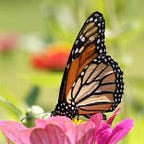FWS Scholar: Joshua Daskin
Joshua Daskin grew up in the Boston and New York suburbs, and remains a Bostonian at heart, happily keeping tabs on the Red Sox and Patriots. Around DC, he volunteers regularly with a group of neighbors to restore a small community park by removing invasive plants and encouraging native species. Josh also enjoys cycling, hiking, camping, and running.
He has a PhD in Ecology and Evolutionary Biology from Princeton University in New Jersey, a M.S. in Zoology from James Cook University in Australia and a B.S. in Biology and Environmental Studies from Brandeis University, Massachusetts. Currently, Josh is a biologist in the headquarters Division of Conservation and Classification. His primary role is to lead assessments of the conservation status of foreign (non-U.S.) species being considered for listing under the Endangered Species Act. He researches and analyzes the species’ biology, population trends, and habitats, as well as the threats facing them and any existing efforts to protect them. Then, he presents the science to the lead ESA policy makers to guide their decision of whether to list and protect a species. With input from partners in the Service’s International Affairs and Law Enforcement programs, Josh then writes and publishes resulting public notices for species that will be listed.
Josh shares, “Briefing policy makers is one of my favorite parts of the current job. It’s rewarding to know the work I’ve done is used to make informed, actionable decisions. Ideally, those decisions help conserve and recover the species we work on.”
While in the Service, Josh has worked on sturgeons (various Eurasian species including: Amur, Russian, ship, Persian, and stellate sturgeons), pangolins, and pygmy three-toed sloths. Nearly all the sturgeons’ habitats have been modified through river channelization, construction of dams, and other changes in water flow, which sturgeon migrations, disrupt spawning, and reduce their food supply. Pangolins are one of the most trafficked mammals in the world, threatened by unsustainable and illegal international trade of their scales, which are used in traditional Asian medicine, and their meat, which is considered a luxury food in many cultures, as well as by habitat loss. The pygmy three-toed sloth lives only on Isla Escudo de Veragus, a small island off the east coast of Panama. A small but mighty group of conservationists, led by Panamanian veterinarian Dr. Diorene Smith, is working on the species’ conservation, completing population surveys in the species’ mangrove habitats, mapping litter and deforestation events, and collaborating with local indigenous groups to educate people on the value of island and sloth conservation.
To form a full picture of the degree to which a species is at risk of extinction, a lot of his work involves synthesis of existing information. This approach is similar to that which he takes in his more independent research, as well. Josh enjoys using creative data sources to answer questions relevant to modern conservation science. For example, he published the first continent-wide assessment of how war affects wildlife by collecting hundreds of historical population estimates for large African mammals and combining them with a database of the locations of armed conflict. The project revealed that war is associated with population declines in many of Africa’s iconic mammals including wildebeest, buffalo, elephants, zebra, giraffe and many antelope species.
As a graduate student and post-doc, Josh also helped reestablish scientific capacity in Mozambique’s Gorongosa National Park, which was then in the early stages of post-war ecological and social restoration. Gorongosa National Park is perhaps Africa’s greatest wildlife restoration story. In 2008, the park had only 10,000 large mammals, today there are over 100,000. Their mission is to advance an integrated multi-partner approach to conservation and to people-centered development, while protecting biodiversity and its ecosystem services.
Josh had the privilege of studying how decades of poaching and subsequent recovery of large wildlife in the park affected Gorongosa’s savannas. He remains involved in studies of recovering wildlife populations there. Josh recently published an article in the Journal of Animal Conservation titled, “Postwar wildlife recovery in an African savanna: evaluating patterns and drivers of species occupancy and richness.” This work was led by collaborators at the University of California and California Department of Fish and Wildlife showing that the number of large mammal species in the park has rebounded and is now comparable to that in the iconic savannas of Tanzania’s Serengeti and Botswana’s Okavango Delta.
Click through to learn more about Josh Daskin’s work conserving foreign species with his colleagues in the the FWS Branch of Delisting and Foreign Species, or see the complete list of threatened, endangered and protected foreign species. Brought to you by the USFWS Conservation Library, #FWSScholar, #WeAreUSFWS.
